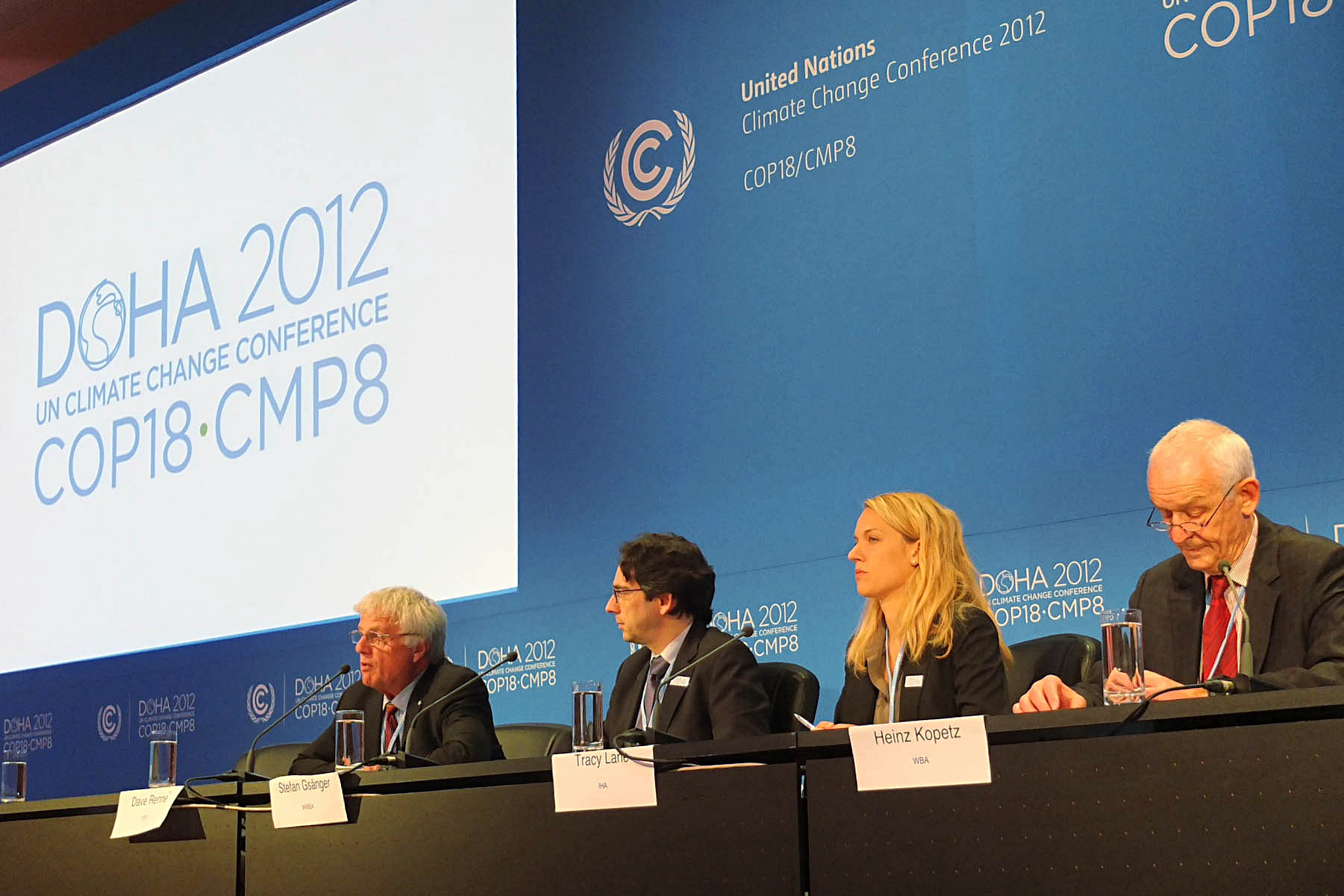By Weiting Chao
Passage au crible n°80
 Source: Wikimedia
Source: Wikimedia
The 18th session of the Conference of the Parties to the UNFCCC (United Nations Framework Convention on Climate Change COP 18) and the 8th session of the Conference of the Parties serving as the Meeting of Parties to the Kyoto Protocol (CMP8) took place in Doha (Qatar) from 26th November to the 8th of December 2012. The outcome of the two-week negotiations, agreed by nearly 200 nations, extends to 2020 the Kyoto Protocol.
> Historical background
> Theoretical framework
> Analysis
> References
Signed in 1997, The Kyoto Protocol is the only global agreement which sets binding obligations on industrialized countries. It is based on the UNFCCC, signed by 153 countries in 1992, which set the goal of reducing GHG emissions (greenhouse gas emissions).
The protocol divides the countries into two groups, Annex I and Non-Annex I countries, with the principle of common but differentiated responsibilities and the principle of equity. In 2001, the United States pulled out of the Protocol, saying that it would damage the US economy. This decision has proved detrimental to the success of the international efforts. Therefore, the EU (European Union) has played a leading role in maintaining the ongoing negotiations.
The Protocol came into effect on 16th of February 2005, following its ratification by Russia. Since the agreement was set to expire at the end of 2012, negotiations about the post-Kyoto period have been underway since 2005. During the Bali Conference (COP13, 2007), the participating nations agreed to the Bali Road Map which set out a two-year process to finalize a binding agreement for 2009 in Copenhagen. However, there was no significant progress and only a diluted version of the agreement was achieved. Indeed, as the Copenhagen Accord was not legally binding, it did not commit countries to agree to a new binding text. In 2011, Russia, Japan and Canada confirmed they would not participate in a second round of emission reductions under the new Kyoto Protocol. Further, the United States reaffirmed their commitment to stay out of the treaty. In 2011, at the Durban Climate Change Conference, a subsidiary body was established: it was an ad hoc Working Group, part of the Durban Platform for enhanced action set up to drive the development of another document. The adoption of a universal agreement on this issue was postponed to 2015, with expected implementation in 2020. In 2011, at the Durban Conference on Climate Change in Doha, however, negotiations led to a simple extension of the Kyoto Protocol until 2020.
1. Procrastination as a negotiation technique. Postponing the signing of a settlement ad libitum, while extending talks, is a well-known diplomatic strategy. The parties can hold up negotiations if they do not want any agreements to be reached.
2. The persistence of the North-South divide. After two decades of negotiations the difficulties between developed and developing countries have worsened considerably because of climate change, making the signing of any new treaty more difficult to achieve.
The Doha agreement is designed to be a tool to resolve the problem of global warming governance. But in reality it only helps to keep the protocol and ensure that negotiations continue to take place. The second period of the Protocol commits the EU, Australia, Belarus, Kazakhstan, Liechtenstein, Norway, Switzerland, Ukraine, and Monaco to another 8 years (1 January 2013 to 31 December 2020). But these countries account for only 15% of global GHG emissions. In addition, they have disparate commitments ranging from a 20% reduction on emissions levels from 1990 for the EU to a decrease of only 0.5% compared to 2000 levels for Australia. Finally, this arrangement does not commit the United States, Canada, Japan, Russia, New Zealand and other emerging countries. However, at the very least, the agreement buys participants more time to implement policies against global warming. In other words, developing countries and countries outside the Kyoto Protocol can still enjoy a secure benefit until 2020. The failure of the first sequence of Kyoto and the withdrawal of United States emphasizes the considerable number of “free riders” who wish to evade the constraints of collective action (Olson). However, when a key player retires, it can be detrimental not only to the other participants but also to the success of the whole arrangement. A second problem is also caused if all stakeholders reject the implementation of the Treaty this would lead to an outright cancellation of the whole agreement. Parties tend to oscillate between these two scenarios because they believe that non-completion is ultimately the strategy that best suits their individual needs. Recent negotiations have been postponed to the post-Kyoto period, as participants remain uncertain about the costs and benefits of such an agreement. Accurate forecasting can be difficult: it can lead to, for example, an underestimation of the future costs. Moreover, parties tend to delay and wait to see how others engage with the agreement. All these factors lead to a state of procrastination. Even though numerous scientific studies have recently shown how the climate might deteriorate more quickly than expected, this policy of procrastination could lead to a major ecological disaster. In other words, the harmful policies of stowaways are already at work.
The conflict between developing countries and industrialized countries forms a central element of environmental governance. Therefore, the principle of common but differentiated responsibilities was recognized in 1992. This principle allows developing countries to increase their emissions to ensure their economic development. However, since some of them have emerged as BASIC countries (Brazil, South Africa, India, and China), the traditional North-South divide has intensified. It is also particularly complicated because China has now become the biggest CO2 emitter in the world, surpassing the emissions of the United States in 2006. During the post-Kyoto negotiations, many developed countries in the UNFCCC – including the United States and Australia – have therefore advocated the replacement of the Kyoto Protocol by a new text, which also includes the commitment of many of the countries of Annex I and developing countries. But for now, developing countries still refuse to accept any obstacle to their development. They demand that developed countries take the lead in a substantial reduction of GHG emissions.
We can see that there is little progress in the fight against global warming. The extension of the Kyoto Protocol only allows the negotiations to continue. To reach a real agreement and prevent an ecological disaster, states should abandon their strategy of procrastination, such as bringing NGOs into discussions. The EU, the U.S. and the BASIC need to play a role in the adoption of a new protocol. If the EU implements emission reductions, the United States and other emerging countries such as China cannot escape the “prisoner’s dilemma” of climate change.
Akerlof, George. A, « Procrastination and Obedience », American Economic Review, 81 (2), 1991, 1-19.
Churchman, David, Negotiation: Process, Tactics, Theory, (2nd Ed.), Boston, University Press of America, 1997.
Kontinen Tiina, Irmeli Mustalahti, « Reframing Sustainability? Climate Change and North-South Dynamics », Forum for Development Studies, 39 (1), mars 2012, 1-4.
Olson Mancur, Logic of Collective Action, Cambridge (Mass.), Harvard University Press, 1965.
Timmons Roberts J., Parks Bradley, A Climate Of Injustice: Global Inequality, North-South Politics, and Climate Policy, The MIT Press, 2006.Site de COP18: http://www.cop18.qa [15 décembre 2012].
Uzenat Simon, « Un multilatéralisme sans contraintes. Les engagements des États dans le cadre de Copenhague », Passage au crible, (15), 18 fév. 2010.




